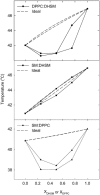A calorimetric study of binary mixtures of dihydrosphingomyelin and sterols, sphingomyelin, or phosphatidylcholine
- PMID: 12719243
- PMCID: PMC1302874
- DOI: 10.1016/s0006-3495(03)70038-1
A calorimetric study of binary mixtures of dihydrosphingomyelin and sterols, sphingomyelin, or phosphatidylcholine
Abstract
The thermotropic properties of binary mixtures of D-erythro-n-palmitoyl-dihydrosphingomyelin (16:0-DHSM), D-erythro-n-palmitoyl-sphingomyelin (16:0-SM), cholesterol, lathosterol, and 1,2-dipalmitoyl-sn-glycero-3-phosphocholine (DPPC) were studied by differential scanning calorimetry. Addition of sterol to 16:0-DHSM and 16:0-SM bilayers resulted in a progressive decrease in both the T(m) and the enthalpy of the main transition. The sterol-induced broad components in 16:0-DHSM endotherms had markedly lower enthalpies than those induced in 16:0-SM. Pretransitions recorded in 16:0-DHSM and 16:0-SM membranes responded differently to low concentrations of cholesterol. The presence of 5 mol % cholesterol increased the pretransition temperature in 16:0-SM bilayers, whereas it decreased the temperature in 16:0-DHSM membranes. Lathosterol behaved in general as cholesterol with regard to its effects on the thermotropic behavior of both sphingolipids, but it appeared to form more stable sterol-rich domains, as seen from the higher T(m) of the broad component, in comparison to cholesterol. Thermograms recorded on binary mixtures of 16:0-SM:16:0-DHSM and DPPC:16:0-DHSM showed that 16:0-SM mixed nearly ideally with 16:0-DHSM, whereas DPPC mixing was less ideal in a 16:0-DHSM membrane. In conclusion, we observed that 16:0-DHSM interactions with sterols differed from that seen with 16:0-SM, and that 16:0-DHSM mixed better with 16:0-SM than DPPC, which indicates that DHSM could function as a membrane organizer within laterally condensed domains.
Figures








Similar articles
-
Phase diagrams of lipid mixtures relevant to the study of membrane rafts.Biochim Biophys Acta. 2008 Nov-Dec;1781(11-12):665-84. doi: 10.1016/j.bbalip.2008.09.002. Epub 2008 Oct 7. Biochim Biophys Acta. 2008. PMID: 18952002 Free PMC article. Review.
-
Membrane properties of D-erythro-N-acyl sphingomyelins and their corresponding dihydro species.Biophys J. 2001 May;80(5):2327-37. doi: 10.1016/S0006-3495(01)76203-0. Biophys J. 2001. PMID: 11325733 Free PMC article.
-
A DSC and FTIR spectroscopic study of the effects of the epimeric 4-cholesten-3-ols and 4-cholesten-3-one on the thermotropic phase behaviour and organization of dipalmitoylphosphatidylcholine bilayer membranes: comparison with their 5-cholesten analogues.Chem Phys Lipids. 2014 Jan;177:71-90. doi: 10.1016/j.chemphyslip.2013.11.008. Epub 2013 Dec 1. Chem Phys Lipids. 2014. PMID: 24296232
-
The effect of side-chain analogues of cholesterol on the thermotropic phase behavior of 1-stearoyl-2-oleoylphosphatidylcholine bilayers: a differential scanning calorimetric study.Biochim Biophys Acta. 1996 Mar 13;1279(2):235-42. doi: 10.1016/0005-2736(95)00258-8. Biochim Biophys Acta. 1996. PMID: 8603092
-
Has nature designed the cholesterol side chain for optimal interaction with phospholipids?Subcell Biochem. 1997;28:145-71. doi: 10.1007/978-1-4615-5901-6_6. Subcell Biochem. 1997. PMID: 9090294 Review. No abstract available.
Cited by
-
Asymmetric addition of ceramides but not dihydroceramides promotes transbilayer (flip-flop) lipid motion in membranes.Biophys J. 2005 Jan;88(1):348-59. doi: 10.1529/biophysj.104.050690. Epub 2004 Oct 1. Biophys J. 2005. PMID: 15465865 Free PMC article.
-
Phase diagrams of lipid mixtures relevant to the study of membrane rafts.Biochim Biophys Acta. 2008 Nov-Dec;1781(11-12):665-84. doi: 10.1016/j.bbalip.2008.09.002. Epub 2008 Oct 7. Biochim Biophys Acta. 2008. PMID: 18952002 Free PMC article. Review.
-
Assembly formation of minor dihydrosphingomyelin in sphingomyelin-rich ordered membrane domains.Sci Rep. 2020 Jul 16;10(1):11794. doi: 10.1038/s41598-020-68688-7. Sci Rep. 2020. PMID: 32678223 Free PMC article.
-
Ceramide acyl chain length markedly influences miscibility with palmitoyl sphingomyelin in bilayer membranes.Eur Biophys J. 2010 Jul;39(8):1117-28. doi: 10.1007/s00249-009-0562-6. Epub 2009 Nov 12. Eur Biophys J. 2010. PMID: 19908035
-
Role of Cholesterol and its Biosynthetic Precursors on Membrane Organization and Dynamics: A Fluorescence Approach.J Membr Biol. 2023 Apr;256(2):189-197. doi: 10.1007/s00232-023-00278-w. Epub 2023 Feb 13. J Membr Biol. 2023. PMID: 36781437
References
-
- Attard, G. S., W. S. Smith, R. H. Templer, A. N. Hunt, and S. Jackowski. 1998. Modulation of CTP: phosphocholine cytidylyltransferase by membrane torque tension. Biochem. Soc. Trans. 26:S230. - PubMed
-
- Bar, L. K., Y. Barenholz, and T. E. Thompson. 1997. Effect of sphingomyelin composition on the phase structure of phosphatidylcholine-sphingomyelin bilayers. Biochemistry. 36:2507–2516. - PubMed
-
- Barenholz, Y. 1984. Sphingomyelin-lecithin balance in membranes: composition, structure, and function relationships. Phys. Membr. Fluidity. 1:131–173.
-
- Barenholz, Y., J. Suurkuusk, D. B. Mountcastle, T. E. Thompson, and R. L. Biltonen. 1976. A calorimetric study of the thermotropic behavior of aqueous dispersions of natural and synthetic sphingomyelins. Biochemistry. 15:2441–2447. - PubMed
-
- Bittman, R., C. R. Kasireddy, P. Mattjus, and J. P. Slotte. 1994. Interaction of cholesterol with sphingomyelin in monolayers and vesicles. Biochemistry. 33:11776–11781. - PubMed
Publication types
MeSH terms
Substances
LinkOut - more resources
Full Text Sources

